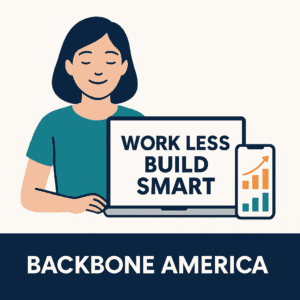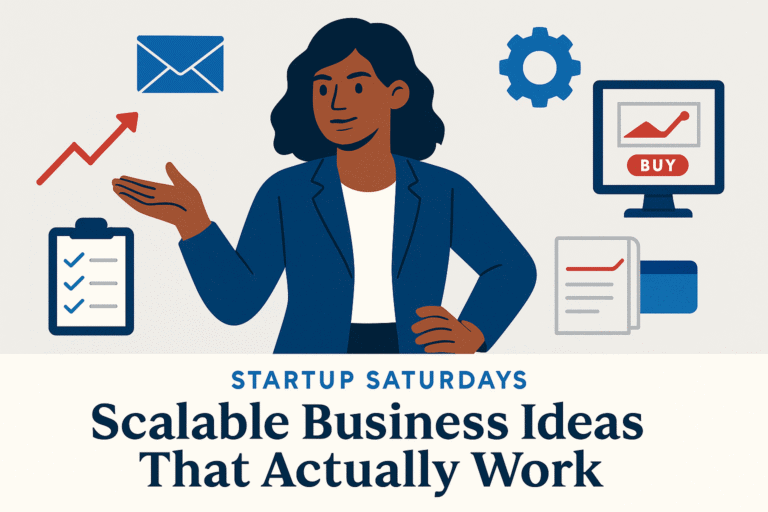Workflow Wednesday
When I first revived Backbone America, I was underwater. Blog posts, product development, marketing, delivery—the list never ended. Every time I crossed one thing off, three more popped up. I couldn’t find the rhythm. And the systems? They weren’t coming fast. Not because I didn’t know better, but because I wasn’t letting go.
I kept trying to hold everything myself, as if willpower alone could build a scalable business. But the truth hit hard: you can’t run lean if everything still runs through you.
It took me longer than I’d like to admit to shift from “doing” to “designing”—to stop reacting and start building systems that could actually carry the weight. Not just to save time, but to save my business from burning me out before it had a real chance.
Running lean isn’t about scraping by. It’s about building smart. And that starts with systems that do the heavy lifting—so you don’t have to.
Lean ≠ Lacking: What It Really Means to Run Lean

That’s not the kind of lean I believe in.
To run lean the right way means being intentional. It means designing a business that minimizes waste—not just financially, but in how you use your time, energy, and attention. It’s about building workflows that run without constant babysitting. Systems that help you deliver consistent value without having to reinvent the wheel every time a client signs on.
In my own journey, I had to shift from this idea that doing more meant being more committed. What I needed wasn’t more effort—it was clarity. Clear offers. Clear processes. Clear boundaries around what actually moved the business forward and what was just noise.
That’s when everything started to change.
Because the truth is: you can run lean and still be generous. You can run lean and still wow your clients. You can run lean and still grow.
You just need systems that make it possible.
Where Founders Waste the Most Time (and Don’t Realize It)

I spent hours tweaking pages that no one was visiting yet. Writing newsletters that weren’t getting opened. Trying to finish digital products while also building funnels, updating my site, setting up automations, testing forms—the list went on. I wasn’t following up with leads because the leads hadn’t come in yet. I was stuck in the build phase, spinning my wheels trying to “get it all ready,” without systems to carry the load.
And because I hadn’t documented anything, I kept repeating the same tasks manually—logging into five different platforms, trying to remember what I did last time, constantly double-checking settings. It wasn’t just inefficient. It was exhausting.
Most people think wasted time happens during delivery or fulfillment. But for solo founders, it often happens before the revenue even shows up. That’s why building lean workflows early matters so much—because even when your business feels small, your time is already stretched.
If that sounds familiar, you’re not behind. You’re just missing the systems that let you shift from scattered effort to strategic flow.
Let Systems Do the Heavy Lifting: Real-World Automation in Action

One of the first real changes I made was documenting repeat tasks. Even if I didn’t automate them yet, I wrote down every step. That gave me clarity—and that clarity became the blueprint for automation.
Now, instead of juggling a thousand tabs and half-finished drafts, I rely on workflows that take over the repetitive parts:
Zoho CRM sends an automated follow-up when someone completes a form—no need to write a new email every time.
Zoho Flow connects tools behind the scenes so I’m not copying data between systems.
Zoho Campaigns handles my nurture sequences, tagging subscribers based on their interests and sending tailored content without me lifting a finger.
These aren’t big, flashy automations. They’re simple, targeted systems that save hours each week and eliminate mental clutter. They help me run lean by turning recurring tasks into something that doesn’t require my constant presence.
And the best part? They work whether I’m actively building or offline for a few days. That’s the difference between owning a business and being buried by one.
If you’re ready to build lean from the start, my Work Less, Build Smart course walks you through how to design the workflows and automations that actually support your life. Not theoretical fluff—real systems for real solo founders who want to scale without burnout.
But What If I’m Not Techy? (You Don’t Have to Be)

I’ve worked in automation professionally. I know how deep the rabbit hole can go—but I also know that you don’t need all that to build a business that runs smoother. The key isn’t technical skill—it’s knowing what you want your system to do, and keeping it focused.
The truth is, most founders get stuck not because they can’t figure out the tools, but because they try to set everything up without a clear process. They try to automate chaos. That’s where things get messy—and expensive.
When I finally got clear on my workflows—what needed to happen, in what order, and what could be templated or triggered automatically—everything clicked. I didn’t need a complex tech stack. I just needed the right system for the stage I was in.
That’s what I teach in Work Less, Build Smart. It’s not about learning more tools—it’s about using the ones you already have (or can learn quickly) to support a business that grows without draining you.
You don’t have to do it all yourself. You just have to stop building from scratch every time.
How to Start: Run Lean Without Going It Alone
If you’re feeling like you need ten more hours in your week just to keep up, I’ve been there. When I brought Backbone America back to life, I was carrying everything—content, offers, marketing, fulfillment—without any real support system beneath me. I wasn’t overcomplicating things on purpose. I just didn’t have the capacity to stop and build the backend the way I knew I should.
That’s the danger of trying to run lean without systems: it turns every task into a time sink. Even simple things become harder when they aren’t repeatable.
You don’t need a complete automation setup to start—just a shift in approach:
Pick one task you repeat often. Write out what you’re doing and when.
Look for friction. What’s taking too long? Where do things fall through the cracks?
Build from there. Whether it’s a checklist, a template, or a simple automation—create one repeatable path.
That’s what I teach inside Work Less, Build Smart. It’s not about hustle. It’s about building with intention—even if you’re doing it part-time, with limited energy and capacity. Especially then.
Running lean doesn’t mean running alone. With the right systems, you can finally stop starting from scratch.
Ready to Let Systems Do the Heavy Lifting?
Running lean isn’t about doing the least—it’s about designing better. And the sooner you build systems to carry the weight, the sooner you’ll stop feeling like your business is balancing on your back.

You don’t need a massive team. You don’t need to quit your job. You don’t even need perfect tools. What you do need is a structure that supports your goals—without draining you in the process.
Work Less, Build Smart is built for that exact reason. It’s not a tech tutorial. It’s a system design course for founders who want to scale without sacrificing their time, energy, or peace of mind.
If you’re ready to run lean—with clarity, with systems, and with space to actually grow—this is where it starts.






